Erosive Drinks Impact on Fluoride Potential Change and Ph Value of Artificial Saliva In Vitro- Juniper Publishers
Juniper Publishers- Open Access Journal of Dentistry & Oral Health
Authored by Dubravka Negovetić Vranić
Abstract
Testing of artificial saliva was carried out in order to prove the effect of erosive drinks on hard dental tissues. The testing was carried out by potentiometric titrator in order to prove the effect of erosive drinks on hard dental tissues. pH measurement was carried out with a pH meter, the most favorable score had again mineral water Jamnica whose pH was 6.04 that is the closest pH value to the natural saliva pH (6-6.5).
Methods: Research was carried out by potentiometric titrator, device that with the help of selective electrodes measures the potential of fluoride ions in individual sample. pH measurement was carried out with a pH meter.
Result: The highest potential of fluorides was in Fanta sample and the lowest in mineral water. The lowest pH was measured in Lemonade and the highest in mineral water.
Conclusion: Proven was possible remineralizing effect of mineral water, because of its ability to replace calcium ions from the lattice hydroxyapatite fluoride ions and consequent remineralizing effect of mineral water, due to its ability to replace calcium ions from the hydroxyapatitelattice with fluoride ions and increase strength of hard dental tissues (enamel and dentin) in artificial saliva therapy.
Keywords: Artificial saliva, Fluoride potential, pH value, remineralisation
Introduction
Dental erosion is defined as the chemical removal of minerals from the hard dental tissue [1,2]. Erosion can be caused by intrinsic or extrinsic factors. Intrinsic factor is gastro-esophageal cause and extrinsic factor is diet [1-3]. Dental erosion is a significant oral health problem in European and Middle-Eastern countries [4]. The results obtained by measurement on a potentiometric titrator and pH meter allow categorization of erosive drinks according to their harmful / potentially positive effect. From the measurements it is possible to read the minimum and maximum potential of fluoride ions. The potential value is inversely proportional to the concentration of ions.
Mineral water drinking has a potential positive effect on tooth structure. pH value of mineral water with 6.04 disables the action of harmful products of metabolism of cariogenic bacteria by interfering with their metabolism and preventing demineralization process. Preparation of artificial saliva was diluted with water in a ratio of 15ml (1 table spoon) artificial saliva Gelclair and 40ml of tap water (3 table spoons) to obtain a solution for mouth rinsing in one minute period. Replacing at least one-third volume of tap water with mineral leads to significant change of the amount of fluoride ions and pH value.
Artificial saliva is intended as a substitute for natural saliva in order to reduce the symptoms of burning and heating, while the solution is retained in the mouth for at least one minute there is also direct contact to the tooth surface with the free fluoride ions which can be incorporated into the tooth structure and prevent demineralization process. In larger amounts ions can stimulate remineralization and their incorporation into the hydroxyapatite lattice. The aim of this study was to evaluate the impact of erosive drinks on change of the potential of fluoride and pH value of artificial saliva in vitro.
Materials and Methods
This study was done in vitro
In study artificial saliva was used called Gelclair (Helsinn Healthcare SA, Via Pian Scairolo 9, Pazzallo, Switzerland). It is concentrated oral viscous gel with a special formula that helps in treating lesions of the oral mucosa (Figure 1). The gel creates a protective coat that is lying flat on the mucous membranes of the oropharyngeal cavity, thereby preventing further irritation and contributes to the rapid pain relief, healing lesions of the mouth, including those caused by drugs, disease, radiation, chemotherapy, oral surgery, traumatic ulcers caused by wearing orthodontic braces, dentures and aging.
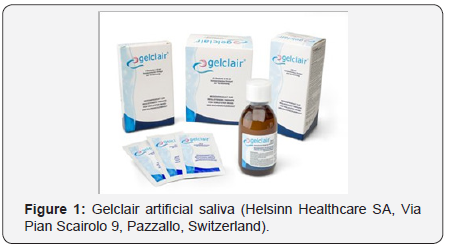
Study was based on the effect of ten different erosive drinks that can be bought over the counter in Croatia: Juicy Fruits Lemonade (Jamnica), Juicy fruits apple (Jamnica), Juicy Fruits multivitamin (Jamnica), Cedevita GO orange (Cedevita doo), Ice tea cranberry (Podravka dd), Coca Cola (Coca-Cola HBC Croatia), Coca Cola (Coca-Cola HBC Croatia), Fanta (Coca-Cola HBC Croatia), Sprite (Coca-Cola HBC Croatia) and Jamnica mineral water ( Jamnica, Croatia). As solvent was used twice purified tap water.
Testing was done on a potentiometric titrator DL 70ES (Metller- Toledo Gmbh, Sonnenbergstrasse 74, CH-Schwerzenbach), a device that is used to determine potential of individual ions on selective electrodes with an accuracy of three decimal places. The electrode was specifically selective for fluorides, which can get the exact value for each sample (Figure 2). Potentiometric titration is a volumetric method used to measure the potential between the two electrodes (referent and indicator electrode).
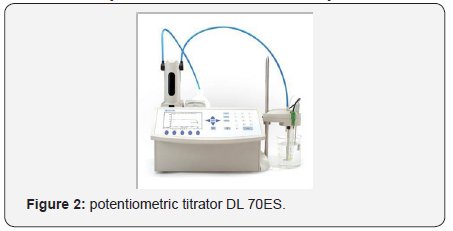
Each sample was prepared in the same manner; in 20ml of water was pipetted 7.5ml of artificial saliva and 6ml of substrate, the total volume was 33.5ml. The device was mixing pattern for 120 seconds followed by a process of measurement using selective electrodes for each sample. Between each measurement, potentiometric probe was cleaned of impurities formed by precipitation from solution in order not to affect the result of the next sample. The second phase of the test was the measurement of the pH of each solution. PHM220 LAB pH meter was used (Radiometer Analytical SAS, 72 rue d`Alsace, 69627 Villeurbanne Cedex, France) (Figure 3), which previously required using calibration with three buffers, first buffer pH value was 12.45 second was 1.67 and third one was 3, 00./p>

Calibration process was carried out at 23 °C. The measurement was repeated for each sample. The pH meter is an electronic instrument that is used to measure the pH (acidity or basicity) of a liquid, consisting of a special measuring probe (glass electrode) connected to an electronic meter that measures and displays the measured pH value. The pH probe measures the pH value and the activity of hydrogen ions.
Results
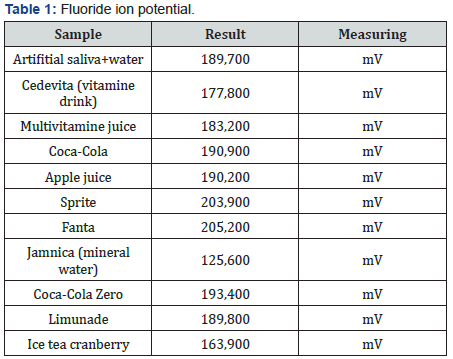
The results of fluoride potential that were measured by using
a potentiometric titrator are expressed in mV (Table 1). As a basic
value solution of water and artificial saliva (189,700mV) was
taken. The greatest potential was in the Fanta sample 205,200mV,
with the lowest amount of fluoride ions, while the lowest potential
was recorded in mineral water with a value of 125,600mV. Based
on measurement changes in potency from the lowest Jamnica
mineral water (125,600)
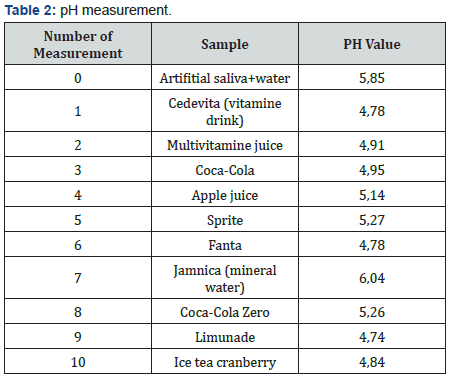
pH measurement was carried out by PHM 220 LAB pH meter
(Table 2). The pH of the basic artificial saliva and water sample
was 5.85. The lowest pH was measured in Lemonade 4.74 and
the highest was measured in mineral water) 6.04. The values
sorted from minimum range are Lemonade (4.74)
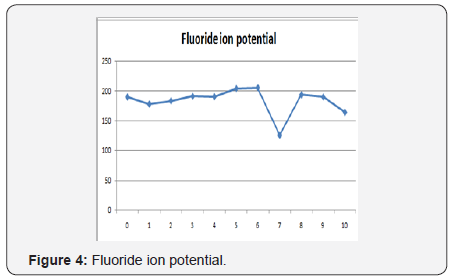
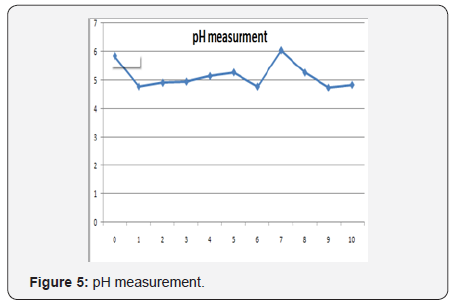
Discussion
The impact of dental erosion includes loss of aesthetic and hypersensitivity [5,6]. The prevalence of tooth erosion is high and continuously is growing up [5]. Measurements in this study have demonstrated the lowest fluoride potential in mineral water, while the value was continuously growing in samples of Cranberry ice tea, Cedevita (vitamin drink), Multivitamin juice, Standard - artificial saliva and water, Lemonade, Apple juice, Coca-Cola, Coca- Cola Zero, Sprite and with the highest value Fanta.
The higher values lead to the lowest amount of free fluoride ions and the impossibility of creating Fluor apatite. The best result was achieved with mineral water, which in its composition has a sufficient amount of free fluorides that can be incorporated into the crystalline lattice of enamel changing place with calcium ions. Mineral water shows better performance than the standard because it contains certain amount of minerals that can in enamel and dentin boost remineralizing effect.
The minimum potential of fluoride ions was measured in Fanta which is therefore the most harmful for the hard dental tissues of all examined erosive drinks. Monitoring pH value changes, the lowest was Lemonade with pH 4.74, followed by Fanta, Vitamin drink, Cranberry ice tea, Multivitamin juice, Coca-Cola, Apple juice, Coca-Cola Zero, Sprite, Standard-artificial saliva+water and the largest pH value had mineral water (6.04). The pH of mineral water is equal to the pH of human saliva, which means that it will not occur enamel erosion as well as demineralization of dental hard tissue.
Among studies that were published with similar issue were also Dugmore and Rock who reported a tooth erosion frequency of 59, 7% in a sample of 12 year old British children [6]. Vered and Lussi published a study based on Israel 15-18 year olds with erosion prevalence rate of 36, 6% and 55-60 year olds with much higher prevalence from 61,9% [7]. Report based on study which included 5 year old school children had shown erosion prevalence of 47% [8]. Biologist and clinicians have studied acidic foods and beverages as risk factor for enamel erosion based mostly on acid containment. Larsen and Nyvad reported influence on enamel erosion caused by soft drinks and orange juice relative to their pH. Erosion was minimal in drinks containing pH above 4, 2, but become more visible on those beverages with pH lower than 4, 0 [9]. Hunter and al examined in vitro tooth erosion by soaking extracted teeth in a fruit drink. Length of exposure to the low pH fluid was connected with severity of erosion, but not proportionally [10].
Dental erosion is new risk factor for oral health connected with everyday lifestyle. It is lesion determined with acid influence on hard dental tissue supported by chemical process without any bacteria cause [11]. Every day consumption of acid drinks and exposure to acidic contamination in working environment become more important than intrinsic gastro-esophageal factor [12-14].
Conclusion
Due to the fluoride ion difference there is potential remineralizing effect of those drinks with a value lower than the standard measurement (artificial saliva and water) while measurements whose potential is higher leads to demineralization of hard dental tissues and progression of caries lesion. The best result was achieved with mineral water, which in its composition has a sufficient amount of free fluoride ions that can be incorporated into the crystalline lattice of enamel, and crystals of hydroxyapatite can changing place with calcium ions.
Mineral water shows better performance than the standard, and can be trigger for remineralizing process and installation of fluoride ions in the tooth enamel. The highest pH was measured in mineral water that shows its remineralizing potential. Tested artificial saliva was mixed according to manufacturer’s instructions in a ratio of 15ml of artificial saliva with 40mL of water, but if the part of water is replaced with mineral water potential of fluoride ions was significantly increased.
For more Open Access Journals in Juniper Publishers please click on: https://juniperpublishers.com/aboutus.php
For more articles in Open Access Journal of Dentistry & Oral Health please click on:
To know more about Open Access Journals please click on: https://juniperpublishers.com/journals.php


Comments
Post a Comment